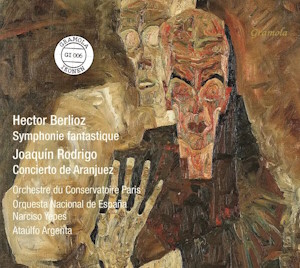
Hector Berlioz (1803-1869)
Symphonie fantastique, Op. 14 (1830)
JoaquÍn Rodrigo (1901-1999)
Concierto de Aranjuez (1939)
Narcisco Yepes (guitar)
Orchestre du Conservatoire de Paris (Berlioz), Orquesta Nacional de España/Ataúlfo Argenta
rec. 1957, Paris (Berlioz)
ADD stereo
Gramola 92006 [73]
A new issue in the Ikonen (Icons) series on the Gramola label, this combines two classic performances of concert favourites from recordings made in 1957, both conducted by Ataúlfo Argenta, who died aged only 44 from accidental carbon monoxide poisoning only a year later, having made many records with the Paris Conservatory Orchestra for Decca – hence, the Berlioz here was produced by John Culshaw. The Rodrigo was presumably recorded in Madrid.
One of the principles behind the series is to re-issue older recordings which were “made using outstanding analog technology” and that is borne out within the first few notes. Clarity, definition, balances and separation are first rate, the remastering having preserved all the best features, leaving the merest hint of tape hiss and occasional background rumble. Pungent French woodwind comes through strongly and the horn is, if anything, preternaturally prominent. The direction is at first surprisingly relaxed; I know more frenetic accounts but it is marked Largo and Argenta is guarding against too-much-too-soon, so from around five minutes in, when Allegro agitato is marked, he starts to turn the screw, upping the pace and tension. There is almost a “period” rawness to the playing here; vibrato is minimal and the edge on the strings is not inappropriate. The succession of brief, contrasting, fast-then-slow passages before the calm ending is deftly handled.
The waltz is swift and there is an apt, underlying sense of hysteria in its swirling, pulsing progress. Again, the woodwind are very characterful and the whole flashes by like a hallucinatory episode; the sense of mounting panic is conveyed through subtle acceleration, punctuated by moments of clarity articulated by the grainy clarinet.
For me, the danger point in this symphony is always in the central Adagio, which can outstay its welcome if it goes slack, but the whistling flutes exude rustic charm, the fleeting storm sections are arresting and the variety of orchestral colour in general staves off longueurs. Argenta’s gift for maintaining tension without compromising the “bucolic idyll” aspect of the music emphasises the obvious kinship of this movement with Beethoven’s Pastoral symphony.
In common with my favourite recordings such as Bernstein’s stupendous version with the Orchestre National de France, Munch, Ormandy and Stokowski – whose attractions are of another, spectacular, “Phase 4” kind – Argenta’s timings are swift, with the exception of the “Marche au supplice”, over which he takes two minutes longer than those illustrious gentlemen. At first I was puzzled and presumed that he was taking “Allegretto non troppo” more seriously than they, but quickly realised that he was taking a repeat at 2:02 after the introduction of the first two themes and before the Fanfare, which virtually no one else does; otherwise his tempi are similar and the very forward pizzicato and blasting trumpets deliver plenty of excitement – even if I doubt whether that repeat is necessary or even desirable.
The “Witches’ Sabbath” is tautly executed; once again, the ability of the Parisian orchestra to colour the wild orchestration vividly and implement all the “effects” such as the col legno strikingly comes to the fore but I would like a little more drive and abandon here of the kind Bernstein evinces.
The companion piece involves a complete change of scene and mood; they make odd bedfellows. The Concierto de Aranjuez has of course been recorded many times by famous guitarists; favourites in my own collection include Pepe Romero, Carlos Bonell and Göran Söllscher but Narciso Yepes was among the greatest and bears comparison with any on them. I would not presume to rank them as they are all superb and very well accompanied.
Again, the recording here is a little papery – not as good as Culshaw’s production above – but still very listenable. The whole work is – to employ a most unsavoury image – just crawling with earworms and a delight throughout. The guitar is recorded a little too close and the light orchestration is too recessed to represent a naturalistic aural picture but we want to be able to hear the fancy fingerwork – which is sometimes a problem live. I prefer the warmer acoustic and better balance of the later recordings but as a souvenir of the work of both guitarist and conductor this is valuable. You would expect two native Spaniards to collaborate successfully on the “soul music” of their homeland and so it proves.
Ralph Moore
Buying this recording via a link below generates revenue for MWI, which helps the site remain free


















